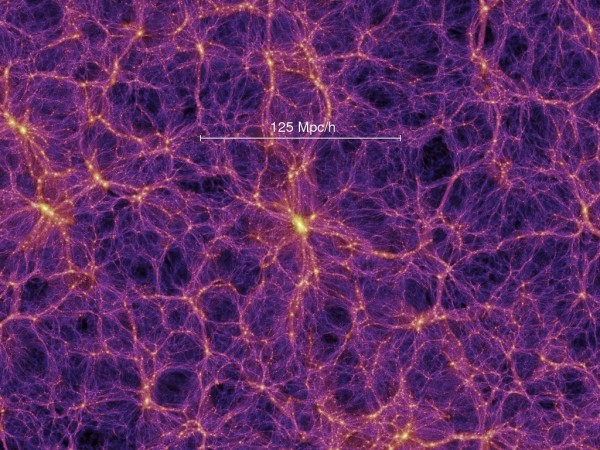Astronomers now think of our universe as a cosmic web, composed of massive filaments of galaxies separated by giant voids. We don’t know in detail what this cosmic web is like. Most of our exploration of it has come via computer models, in particular the cold dark matter model for galaxy formation, the model currently favored by most cosmologists. The model shows that filaments in the cosmic web – essentially long threads of gas – provide the fuel for the intense formation of stars and supermassive black holes. On October 4, 2019, astronomers said they’ve now obtained images of a particularly bright portion of the cosmic web, including threads of gas extending over 3 million light-years. They say it’s the first time the cosmic web has been imaged in such detail on that large a scale. And behold, the observations agree with what has been theorized. The region where these enormous filaments meet is home to an “exceptional number,” they said, of supermassive black holes and starbursting galaxies with very active star formation.
According to current theories of galaxy formation, such intense activity can only be triggered and sustained over time if large amounts of gas are funneled into the assembling cluster from the surrounding regions.
The group found that the detected filaments in the cosmic web contained a significant reservoir of gas. This gas, they expect, is what helps fuel the continued growth of galaxies in this region.
These astronomers are from the RIKEN Cluster for Pioneering Research in Japan and Durham University in the U.K. They have a new paper out, published in the peer-reviewed journal Science. An introduction to their paper explains:
Most gas in the universe lies in the intergalactic medium [between the galaxies], where it forms into sheets and filaments of the cosmic web. Clusters of galaxies form at the intersection of these filaments, fed by gas pulled along them by gravity. Although this picture is well established by cosmological simulations, it has been difficult to demonstrate observationally.

The new research was carried out using observations from the Multi Unit Spectroscopic Explorer (MUSE) at the European Southern Observatory’s Very Large Telescope. Their statement explained:
The astronomers detected the filaments of gas using the characteristic radiation produced when the neutral hydrogen gas they contain is excited by surrounding ultraviolet light and then returns to its lowest state of energy.
The detected radiation was too intense to originate only from the typical background level of ultraviolet light that permeates the universe, and the researchers’ models instead suggest that it is driven by the light emitted from the many star-forming galaxies and black holes in the region.
Lead author Hideki Umehata, of the RIKEN Cluster for Pioneering Research and the University of Tokyo, said:
The presence of such intense radiation suggests very strongly that gas falling along the filaments under the force of gravity triggers the formation of many starbursting galaxies and supermassive black holes, ultimately giving the universe the structure that we see today.
Previous observations have shown similar emission from blobs of gas extending beyond galaxies, but now we have been able to clearly show that these filaments stretch to much larger distances, going even beyond the edge of the field that we viewed.
This adds credence to the idea that these filaments are actually powering the intense activity that we see in galaxies within large structures assembling in the early universe.

Bottom line: Astronomers in the U.K. and Japan probed the cosmic web, a large-scale structure composed of massive filaments of galaxies separated by giant voids. They found the filaments also contained significant amounts of gas, believed to help fuel the galaxies’ growth. The new observations give scientists a way to map the cosmic web directly and to understand in detail its role in regulating the formation of supermassive black holes and galaxies.
Source: Gas filaments of the cosmic web located around active galaxies in a protocluster











